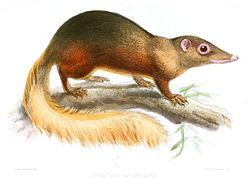| Euarchontoglires Temporal range: | |
|---|---|
 | |
| From top to bottom (left): rat, treeshrew, colugo; (right) hare, macaque with human. | |
| Scientific classification | |
| Kingdom: | Animalia |
| Phylum: | Chordata |
| Class: | Mammalia |
| Magnorder: | Boreoeutheria |
| Superorder: | Euarchontoglires Murphy et al., 2001 [1] |
| Subgroups | |
| |
Euarchontoglires (from Euarchonta 'true rulers' + Glires 'dormice'), synonymous with Supraprimates, is a clade and a superorder of placental mammals, the living members of which belong to one of the five following groups: rodents, lagomorphs, treeshrews, primates, and colugos.





